By Robert Klein and Cody Creech
Weed emergence and growth in post-harvest wheat will be accelerated this year because of the shorter and thinner wheat. See Figure 1 on this year's shorter and thinner wheat, and Figure 4 on how straw level affects the weed population.
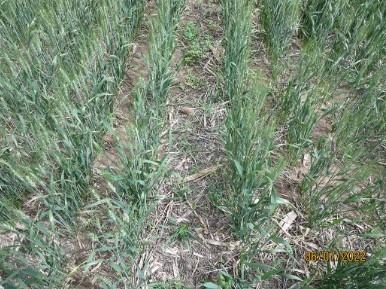 Figure 1. This year’s shorter and thinner wheat — note weeds in the less competitive wheat.
Figure 1. This year’s shorter and thinner wheat — note weeds in the less competitive wheat.One needs to control the already emerged weeds — best controlled before they exceed four to six inches — and also prevent later weeds from emergence. Residual herbicides can reduce the number of herbicide applications.
The value of controlling weeds in wheat stubble after wheat harvest was the results of research by the late Gail Wicks, that concluded three inches of water were saved in the soil profile when weeds were controlled in a timely manner after winter wheat harvest. Subsequently, each inch of soil water increases the yield of corn or grain sorghum by approximately 12 bushels the following year.
Also, experience with controlling weeds after wheat harvest sometimes resulted in yields of as much as 100 bushels more per acre compared to fields where the weeds were not controlled after harvest. Where does the “as much as 100 bushel” increase in yield occur? That happens when the corn or sorghum without timely weed control after winter wheat harvest has three inches less soil water and is lost to drought, and the crop with timely weed control after winter wheat harvest with three inches more soil water can hang on longer in the drought and receives moisture before it uses up the additional three inches of soil water. How much yield increase depends on the amount of additional moisture.
When Ecofallow Cropping System (Ecofallow is controlling the weeds during the fallow period — after winter wheat harvest until the following crop is planted the next spring — by using herbicides and/or tillage with minimum disturbance of crop residues and soil) began in the early 1970s, the main herbicides used were paraquat and atrazine. Some did not want the extra cost of paraquat so they used a sweep blade to kill the weeds — which also included those that added sprayers to their sweep machines — to spray the atrazine at the same time they used the sweep. This usually was not a good practice when you consider the soil water loss from tillage and not having a firm seedbed to plant into the next spring.
The crop following the Ecofallow period is referred to as Ecofallow corn or Ecofallow sorghum. Crop producers who had problems with weeds in their corn or sorghum found it was usually the result of not controlling the weeds timely or not at all after wheat harvest. This, of course, did not make it Ecofallow corn or sorghum. This permitted the weeds to use soil water and produce a great deal of seed since there was no crop competition in the fallow.
Volunteer wheat not controlled after harvest and allowed to overwinter was difficult to control with the herbicides that were available at that time. A treatment that usually worked was two pounds of triazine herbicide (one pound of atrazine and one pound of Bladex), paraquat, NIS and 20 gallons of 28-0-0. Volunteer wheat, when not controlled after harvest, creates similar issues as weeds using water and nutrients.
In addition, volunteer wheat not controlled after harvest — especially early volunteer as a result of a hailstorm — is a major factor with the disease Wheat Streak Mosaic (see this article). Furthermore, volunteer wheat not controlled after harvest can also serve as a host for cutworms and cause problems in Ecofallow corn and Ecofallow sorghum.
The challenge to make the Ecofallow production system (later called Ecofarming, which is a system of controlling weeds and managing crop residues throughout a crop rotation with minimum use of tillage to reduce soil erosion and production costs, increasing weed control, water infiltration, moisture conservation and crop yield) work increased when kochia became resistant to the triazine herbicides and later additional herbicides. However, like most things, it can get worse. A farmer recently commented that he thought kochia being resistant to several herbicides was a major problem — that is, until he experienced herbicide-resistant Palmer amaranth.
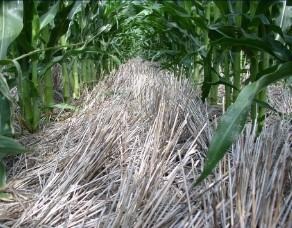 Ecofallow corn
Ecofallow cornTiming
Weeds under stress are difficult to control with herbicides. Kochia and Russian thistle are day-length sensitive and will begin to flower toward the end of July and into August. It is a general rule that you can wait up to 30 days after harvest to spray wheat grown as part of a three-year rotation, unless you have weeds like Palmer amaranth, which should be controlled by the time they reach three to four inches inches in height. If the wheat was planted without an 11- to 14-month fallow period, spray it within 15 days of harvest. Examine each field separately and adjust your treatment schedule accordingly.
This year, some fields may need to be sprayed before 15-30 days because of the less competitive winter wheat stands. The key is to be timely controlling weeds to prevent weeds from using soil water and producing weed seeds.
As with all weed control, it is essential that you closely watch for weed developments and spray at the proper time noted on the label to achieve maximum control. Most labels state that weeds must be treated before they are six inches tall. If weeds are under severe drought stress, wait for rain and spray about a week later.
With many weeds developing resistance to several herbicides, we are back to using paraquat in many of our burndown treatments. The standard rate of paraquat in the 1970s was 16 ounces per acre. To obtain adequate control at those rates, proper timing and spray coverage was critical. The following recent research by Kansas State University helps increase our knowledge on paraquat and other treatments for Palmer amaranth.
Efficacy of Late-Season Herbicide Programs for Controlling Palmer Amaranth in Postharvest Wheat Stubble
R. LIU, V. KUMAR, N. AQUILINA, AND T. LAMBERT
Summary
Late-season control of Palmer amaranth in postharvest wheat stubble is a challenge for Kansas producers. The objective of this study was to determine the effectiveness of POST herbicide programs (with multiple modes of actions) for late-season control of Palmer amaranth in postharvest wheat stubble. The study was conducted at the Kansas State University Agricultural Research Center in Hays, Kansas, in 2019.
The study site had a natural seedbank of Palmer amaranth that emerged immediately after wheat harvest. All selected herbicide programs were tested three weeks after wheat harvest, when Palmer amaranth plants had attained a height of 2-2.5 feet with inflorescence initiation. Twenty-four herbicide programs comprising Roundup PowerMax, Clarity, 2,4-D, Aatrex, Gramoxone, Sencor, Valor SX, Spartan, Sharpen, Authority Supreme, Kochiavore, Panther MTZ and Huskie applied alone or in tank-mixtures were tested at recommended-use rates. All herbicide treatments were arranged in a randomized complete block design with four replications. Visual Palmer amaranth control was assessed at two, four and eight weeks after treatment (WAT) by using a rating scale of 0–100% (where 0 = no control and 100% = complete plant death). The aboveground Palmer amaranth biomass and seed production were determined by harvesting plants from a 10.7-ft2 quadrat placed at the center of each plot 8 WAT.
All tested herbicide programs, except Kochiavore and a tank-mixture of Huskie + Aatrex provided > 88% control of Palmer amaranth 8 WAT. In contrast, late-season control of Palmer amaranth did not exceed 71% at 8 WAT with Kochiavore or a tank-mixture of Huskie plus Aatrex treatments. Consistent with visual control (%), a majority of those tested programs significantly reduced shoot dry weights (>77% reduction) and seed production (>93% reduction) of Palmer amaranth compared to non-treated weedy check.
Overall, these results suggest that several POST herbicide programs exist that growers can utilize for effective late-season control of Palmer amaranth in postharvest wheat stubble.
Table 1. List of herbicide programs tested for controlling Palmer amaranth in post-harvest wheat stubble at the Kansas State University Agricultural Research Center in 2019 (click to view)
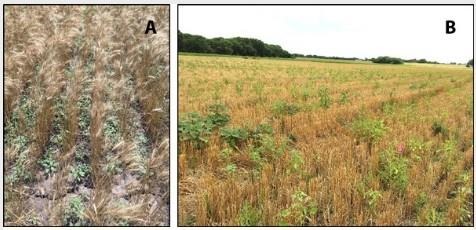 Figure 2. (A) Emerged Palmer amaranth seedlings under poor wheat canopy, and (B) Palmer amaranth growth in post-harvest wheat stubble at the time of herbicide applications in 2019. Photos by Vipan Kumar, K-State Research and Extension.
Figure 2. (A) Emerged Palmer amaranth seedlings under poor wheat canopy, and (B) Palmer amaranth growth in post-harvest wheat stubble at the time of herbicide applications in 2019. Photos by Vipan Kumar, K-State Research and Extension.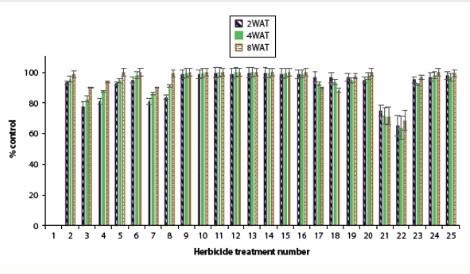 Figure 3. Effect of late-season herbicide programs on Palmer amaranth control at two, four and eight weeks after treatment (WAT) in post-harvest wheat stubble (see Table 1 for herbicide treatment number).
Figure 3. Effect of late-season herbicide programs on Palmer amaranth control at two, four and eight weeks after treatment (WAT) in post-harvest wheat stubble (see Table 1 for herbicide treatment number).Conclusions and Implications
These preliminary results indicated that several alternatives (other than glyphosate) POST burndown herbicides — including Clarity, 2,4-D, Gramoxone, Sharpen and Liberty — exist which can be utilized in combination with Aatrex, Authority Supreme, Panther MTZ, Sencor, Spartan and Valor for effective late-season control of Palmer amaranth in postharvest wheat stubble.
Important note: Growers are advised to read each herbicide label for rotational crop restrictions (for next summer crop) before using any of these mentioned products.
Brand names appearing in this publication are for product identification purposes only. No endorsement is intended, nor is criticism implied of similar products not mentioned. Persons using such products assume responsibility for their use in accordance with current label directions of the manufacturer.
Vipan Kumar, Weed Management Specialist, Agricultural Research Center – Hays, Kansas: vkumar@ksu.edu
Rui Liu, Assistant Scientist, Agricultural Research Center – Hays, Kansas: tabitha723@ksu.edu
Split Treatments
Split treatments have a good history of effectiveness.
When using a split treatment, apply the glyphosate products with companion herbicides, if glyphosate-resistant weeds are present in the field, (adding surfactant, if needed, plus ammonium sulfate) as the first application in July or early August. Some glyphosate products include sufficient surfactant while many products require more. Be sure to check the product label.
For all glyphosate brands, add ammonium sulfate (spray grade) at 17 lb per 100 gallons of spray solution. The ammonium sulfate is the first item put into the spray tank after the water. Ammonium sulfate is especially helpful when stress conditions are present. Liquid ammonium sulfate, with or without a drift retardant, also is available. Check to ensure that the rate of liquid ammonium sulfate is adequate. It is difficult to recognize weed stress, so it is wise to always add ammonium sulfate.
Split herbicide treatments provide for timely management of post-harvest weeds in wheat. Consider making the first post-harvest application between early to mid-July and early August depending on your location in the state. The second part of the treatment can be applied in September.
Improve control by increasing the rate of glyphosate for weeds not resistant to glyphosate. Do not exceed the label use rates. Allow at least six hours — and longer with some weeds — for the glyphosate product to become rainfast. Barnyardgrass may require 24 hours without rain for maximum control. With glyphosates, use a spray volume of seven to 10 gallons per acre and don't apply when temperatures reach or exceed 90°F.
Be careful in selecting herbicides used near susceptible crops or other sensitive vegetation. Sharpen may help with the control of pigweeds and provide some residual control. Sharpen works best with the addition of methylated seed oil and can provide good burndown on smaller weeds. However, if the weeds are very big, it tends to burn the tops and plants eventually resume growth. Sharpen requires complete coverage so using 15 to 20 gallons/acre spray solution is important.
One herbicide alternative to glyphosate that can work well to control emerged pigweed and kochia is paraquat. See previous information from Kansas above. Paraquat is a contact herbicide, so spray coverage is critical. Spray volumes of 20 gallons/acre or higher are preferred, especially on larger and thicker weeds. Paraquat also needs to be applied with a nonionic surfactant or oil concentrate to enhance surface coverage of the plant foliage. A tank mix with atrazine will enhance control and provide some residual weed control if planning to plant corn or sorghum next spring. Likewise, metribuzin can be tank-mixed with paraquat if rotating to soybean to enhance control and provide some residual. If planting wheat this fall, a tank mix with Sharpen is an option to provide some residual control. Recent work suggests that applying paraquat as soon as possible following wheat harvest allows for better coverage and more effective control, especially of pigweeds.
Another herbicide that can be added to the burndown treatments for residual broadleaf weed control in wheat stubble is flumioxazin (Valor and others). Flumioxazin has been used as a preplant/preemergence treatment in soybeans for years, but it hasn’t been used much in wheat stubble because of the cost. However, with the recent reduction in flumioxazin prices, it may be cost-effective. Control with flumioxazin will depend on rainfall for activation, just as with the preplant treatment in soybeans.
Tank mixes with glyphosate will help control weeds that are difficult to control with glyphosate alone and will help reduce the chances of developing glyphosate-tolerant weed populations. Always check labels and rotation restrictions.
If temperatures are above 80°F, use the amine formulation of 2,4-D. Do not use 2,4-D or dicamba if sensitive crops or other vegetation may be affected. For additional information, treatments, and rates, go to the Ecofarming Section of the 2022 Guide for Weed, Disease and Insect Management in Nebraska EC130.
The second part of the split treatment should be applied in September. It should contain at least 0.5 lb per acre of atrazine and possibly paraquat (add surfactant), depending on the amount and size of volunteer winter wheat, downy brome, jointed goatgrass or other weeds present.
Herbicide weed control can be challenging when spraying into tall wheat stubble because the stubble intercepts the spray droplets. Recent research in the Nebraska Panhandle indicated that 12-inch stubble intercepted over 20% of the spray solution compared to tall stubble, which was close to 40%. Spray droplet penetration can increase by using coarse droplets and by traveling in an angular direction compared to the old wheat rows. Figure 4 shows how crop residue levels affect weeds and their control.
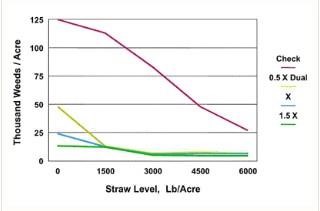 Figure 4. The effect of winter wheat crop residue levels on weeds in corn following winter wheat treated with herbicides post-harvest. In general, one bushel of wheat produces 100 lb of crop residue or 60 bushels of winter wheat produces 6,000 lb of crop residue.
Figure 4. The effect of winter wheat crop residue levels on weeds in corn following winter wheat treated with herbicides post-harvest. In general, one bushel of wheat produces 100 lb of crop residue or 60 bushels of winter wheat produces 6,000 lb of crop residue.Weed Challenges
Several options are available for using nonselective herbicides with difficult-to-control weeds. With paraquat, use a minimum of two pints of X-77, or equivalent surfactant, per 100 gallons of solution. Use two quarts of X-77 per 100 gallons of spray solution if using less than 20 gallons of carrier. The active ingredient varies among products, so check labels and adjust rates accordingly.
The atrazine rate varies with soil and rainfall patterns. In southwest Nebraska, use two quarts of atrazine per acre unless the soil or the following crop limits the rate to a lower amount. In the Panhandle, the maximum allowed in one season is often 0.5 quart per acre.
Volunteer Wheat and Grasses
The advantage of split treatments is that they provide excellent control of volunteer winter wheat and other winter annual grasses. Using one quart or less of atrazine before Sept. 10 allows winter wheat to be planted 12 months later in most areas and most soils. If sufficient soil water is available the following spring, corn could be planted or if moisture is limited, the field could be fallowed and winter wheat could be planted in the fall.
Downy Brome
If downy brome is a problem and a winter wheat-fallow rotation is being used, tillage is usually recommended immediately after harvest to plant the seeds and ensure maximum weed germination during the fallow period. Do not till if only a limited amount of crop residue is present after harvest since tillage will make the soil susceptible to wind and water erosion. Herbicides are available to control downy brome in the growing winter wheat and are best applied early. If jointed goatgrass and/or feral rye is a problem, use a rotation where wheat is not planted for at least three years.
Jointed Goatgrass and Feral Rye
Herbicide-tolerant winter wheat varieties are available for fields with jointed goatgrass or feral rye problems. Beyond™ herbicide is used in the Clearfield wheat system. Aggressor herbicide can be used in the CoAXium Wheat Production System.
Source : unl.edu